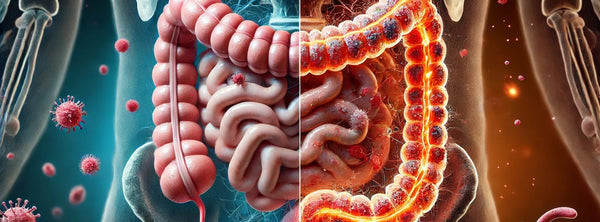
-
Candida Overgrowth: When a Normal Yeast Becomes a Big Problem
Candida is a type of yeast that naturally lives in our digestive tract, mouth, and on the skin. In small amounts, it’s harmless — even helpful — assisting with digestion and keeping other microbes in check. But when conditions shift in its favour, Candida can grow out of control, moving from a quiet passenger to an uninvited guest that impacts your health in surprising ways.
How Candida Affects the Gut and Beyond
Imagine your gut lining as a well-guarded fortress, keeping the good stuff in and the bad stuff out. When Candida is under control, that wall stays strong. But when it overgrows, it can send out long root-like filaments (rhizoids) that pierce the intestinal wall. This weakens your gut barrier and creates tiny gaps — often called "leaky gut” — that let unwanted particles, toxins, and even Candida’s own by-products slip into your bloodstream.
One of the main toxins produced by Candida is acetaldehyde — the same chemical that contributes to hangovers. In the body, acetaldehyde can put stress on your liver, irritate tissues, and affect how you feel physically and mentally. This is why Candida can trigger such a wide mix of symptoms — from digestive discomfort to foggy thinking and low energy.
The Hidden Damage Candida Can Cause
Because Candida affects multiple systems at once, symptoms can seem unrelated: bloating, brain fog, skin issues, sinus problems, joint pain, fatigue — and more. This is why it’s often overlooked or misdiagnosed. One person might be battling constant digestive upsets, another might struggle with low mood and brain fog, while someone else has stubborn skin rashes — yet the root cause can be the same overgrowth hiding in the gut.
Left unchecked, Candida can disrupt nutrient absorption, put extra stress on your liver, and create ongoing inflammation that leaves you feeling “not quite right” even if blood tests look normal. For many people, it’s this hidden, low-grade disruption that slowly chips away at their energy, mood, and overall health — often for years before the connection is made.
-
Why Candida Gets Out of Control
Your immune system and beneficial gut bacteria normally keep Candida under control. But when your immune defences are lowered or your gut bacteria are damaged, Candida can quickly multiply. This often happens after antibiotics, certain medications, or ongoing stress — all of which reduce your body’s natural checks and balances.
Everyday Triggers That Feed Candida
These common factors can weaken your immunity, disrupt healthy gut bacteria, or directly feed Candida — giving it the perfect conditions to grow:
- Antibiotics, birth control pills, corticosteroid medications — can wipe out beneficial gut bacteria or suppress immune function, leaving Candida unchecked.
- High-sugar and refined carbohydrate diets — provide a quick food source for Candida, helping it multiply rapidly.
- Alcohol and fermented foods — contain sugars or yeast that can fuel Candida growth and irritate the gut lining.
- Chronic stress and lack of rest — raise stress hormones that lower immunity and alter digestive function.
- Low stomach acid or digestive enzyme levels — make it harder to break down food, leading to fermentation and a better environment for Candida.
- Environmental toxins such as pesticides, herbicides, and heavy metals — place extra strain on the liver and immune system.
- Chlorinated or fluoridated water — can damage beneficial gut bacteria over time.
- Hormonal imbalances and underactive thyroid — can slow digestion and alter immune response, favouring Candida growth.
- Processed and nutrient-poor foods — deprive your body of the nutrients it needs to maintain strong defences.
The more of these factors that are present in your life, the more opportunities Candida has to gain the upper hand. Understanding what’s feeding it — and what’s weakening your defences — is the first step in turning the tide back in your favour.
-
Why Candida Symptoms Can Be So Confusing
Candida can cause over 100 different symptoms, and they can vary from person to person. Because it impacts digestion, immunity, hormones, skin, and even mood, it often mimics other conditions — making it tricky to identify without a thorough assessment.
Common Signs of Candida Overgrowth
- Bloating, gas, Constipation , or Diarrhoea
- Cravings for sugar, bread, or alcohol
- Brain fog, poor concentration, or memory issues
- Persistent fatigue or feeling drained
- Recurrent thrush, urinary tract, or sinus infections
- Skin rashes, eczema, psoriasis, or nail fungus
- Headaches, mood swings, Anxiety, or depression
- White coating on the tongue, bad breath or reflux
- Joint or muscle aches
What Makes Candida Symptoms Flare Up
If you’ve ever felt fine one day and bloated, foggy, or itchy the next, you’ve experienced how reactive Candida can be. Hot, humid weather can make symptoms worse, as can eating certain foods. Sugar, alcohol, refined carbs, and processed snacks act like fertiliser for Candida, helping it multiply and release more toxins. The more it grows, the more your symptoms can intensify.
Stress — whether it’s mental, emotional, or physical — is another major trigger. It signals your body to divert energy away from immune defence, giving Candida the space it needs to thrive. Add in environmental exposures such as pollution, heavy metals, and chemical residues, and you have the perfect storm for a flare-up.
If these symptoms sound familiar, don’t ignore them — especially if they keep coming back. Addressing Candida early can help you avoid the ongoing cycle of flare-ups, discomfort, and frustration that many people face for years without answers.
-
The Two-Step Approach That Works Best for Candida
The most effective way to deal with Candida is to tackle it from two angles: starve it of the foods it thrives on, and use natural antimicrobials and probiotics to bring it under control. At the same time, supporting your immune system and gut health helps stop it from coming back.
Why Diet Alone Often Isn’t Enough
Cutting out sugar, alcohol, and refined carbs is an essential first step — but diet alone can be a slow, uphill battle. Candida can be resilient, and even with perfect eating habits, it may take months or years for overgrowth to settle. Many people find that progress stalls or symptoms return as soon as their diet relaxes.
By combining diet changes with targeted antifungal herbs, probiotics, liver support, and digestive enzymes, you can help disrupt Candida’s stronghold, restore microbial balance, and support your body’s natural defences. This combination tends to deliver results faster, and more importantly, helps you maintain them.
The Complete Candida Reset Plan
Over the years in clinic, we’ve seen what works — and what leaves people stuck in a cycle of “better for a while, then worse again.” The key is a structured, step-by-step approach that addresses diet, gut balance, and immune strength together.
That’s exactly why we created the Candida Reset Program — a guided plan that brings all the pieces together. It gives you the practical steps, recipes, and supplement support you need to create an environment where Candida can no longer dominate.
This comprehensive program includes:
- Free Candida Treatment Plan — A detailed guide with dietary, lifestyle, and supplement recommendations used successfully in our clinic.
- Eating Right For Candida Recipe E-Book — Over 80 easy and delicious recipes tailored to each stage of the program (Downloadable PDF).
- Candida Supplement Pack — The exact supplements and dosages outlined in the treatment plan.
Please note: This protocol is suitable for persons over 15 years of age, for those younger please contact our clinic.
By following a clear, structured plan, you can give your body the best chance to regain balance and reduce the daily impacts Candida can have on your wellbeing. The aim is to help you feel lighter, clearer, and more in control of your digestive health — without the guesswork, confusion, or wasted time trying to piece it all together on your own.



